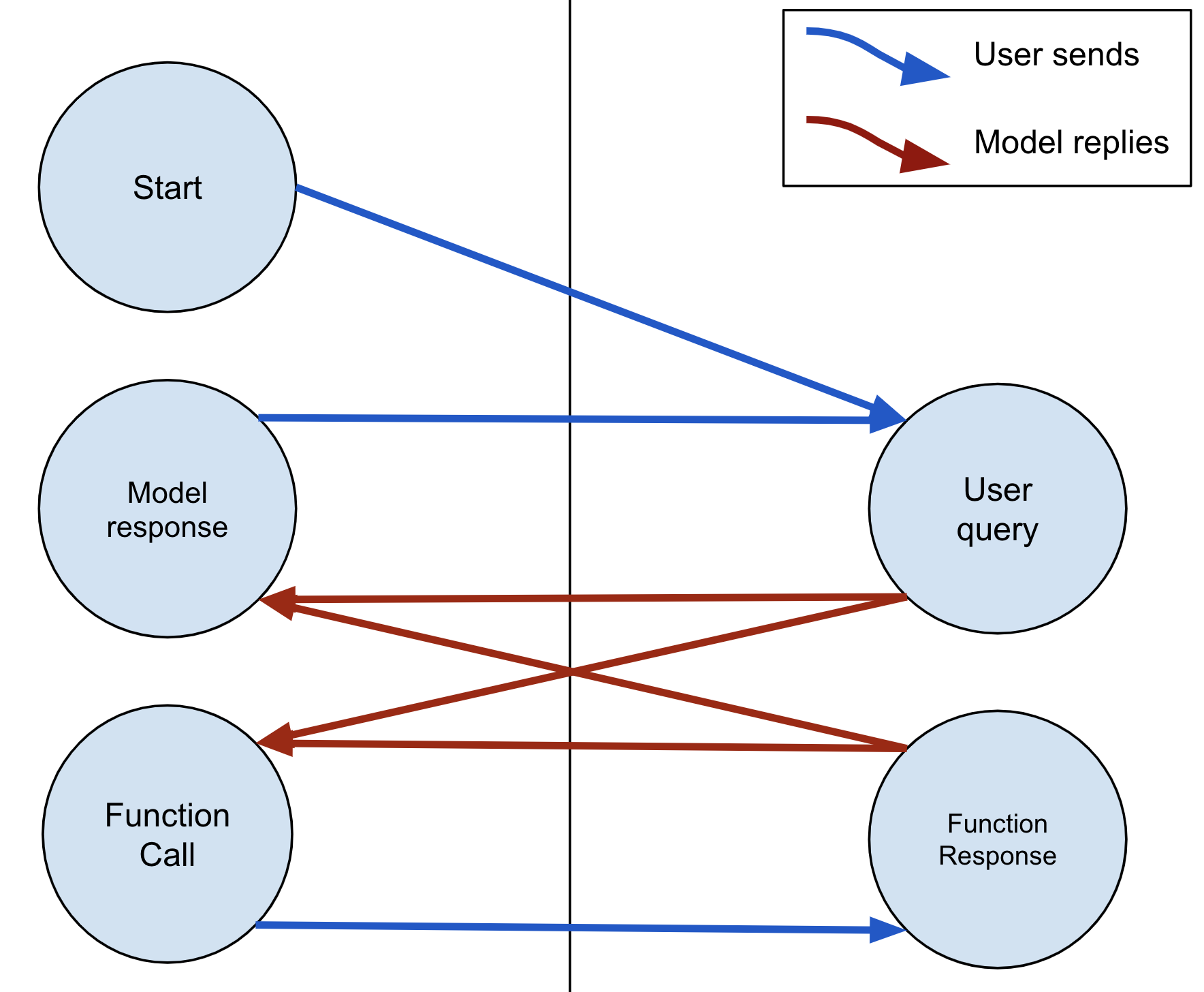|
|
 在 Google Colab 中运行 在 Google Colab 中运行
|
 查看 GitHub 上的源代码 查看 GitHub 上的源代码
|
您可以为 Gemini 模型提供函数说明。模型可能会要求您调用一个函数并发回相应结果,以帮助模型处理您的查询。
初始设置
安装 Python SDK
适用于 Gemini API 的 Python SDK 包含在 google-generativeai 软件包中。使用 pip 安装依赖项:
pip install -U -q google-generativeai
导入软件包
导入必要的软件包。
import pathlib
import textwrap
import time
import google.generativeai as genai
from IPython import display
from IPython.display import Markdown
def to_markdown(text):
text = text.replace('•', ' *')
return Markdown(textwrap.indent(text, '> ', predicate=lambda _: True))
设置您的 API 密钥
您必须先获取 API 密钥,然后才能使用 Gemini API。如果您还没有密钥,请在 Google AI Studio 中一键创建。
在 Colab 中,将密钥添加到 Secret 管理器中左侧面板中的“🔑?”下。将其命名为 API_KEY。
获得 API 密钥后,将其传递给 SDK。可以通过以下两种方法实现此目的:
- 将密钥放在
GOOGLE_API_KEY环境变量中(SDK 会自动从该变量中获取密钥)。 - 将密钥传递给
genai.configure(api_key=...)
try:
# Used to securely store your API key
from google.colab import userdata
# Or use `os.getenv('API_KEY')` to fetch an environment variable.
GOOGLE_API_KEY=userdata.get('GOOGLE_API_KEY')
except ImportError:
import os
GOOGLE_API_KEY = os.environ['GOOGLE_API_KEY']
genai.configure(api_key=GOOGLE_API_KEY)
函数基础知识
您可以在创建 genai.GenerativeModel 时将函数列表传递给 tools 实参。
def multiply(a:float, b:float):
"""returns a * b."""
return a*b
model = genai.GenerativeModel(model_name='gemini-1.0-pro',
tools=[multiply])
model
genai.GenerativeModel(
model_name='models/gemini-1.0-pro',
generation_config={},
safety_settings={},
tools=<google.generativeai.types.content_types.FunctionLibrary object at 0x10e73fe90>,
)
使用函数调用的推荐方法是通过聊天界面使用。主要原因在于,FunctionCalls 非常适合聊天的多轮结构。
chat = model.start_chat(enable_automatic_function_calling=True)
启用自动函数调用后,如果模型要求,chat.send_message 会自动调用您的函数。
它似乎只会返回包含正确答案的文本响应:
response = chat.send_message('I have 57 cats, each owns 44 mittens, how many mittens is that in total?')
response.text
'The total number of mittens is 2508.'
57*44
2508
如果您查看 ChatSession.history,则会看到事件的顺序:
- 您发送了问题。
- 模型回复了
glm.FunctionCall。 genai.ChatSession在本地执行了该函数,并向模型发回了一个glm.FunctionResponse。- 模型在其回答中使用了该函数输出。
for content in chat.history:
part = content.parts[0]
print(content.role, "->", type(part).to_dict(part))
print('-'*80)
user -> {'text': 'I have 57 cats, each owns 44 mittens, how many mittens is that in total?'}
--------------------------------------------------------------------------------
model -> {'function_call': {'name': 'multiply', 'args': {'a': 57.0, 'b': 44.0} } }
--------------------------------------------------------------------------------
user -> {'function_response': {'name': 'multiply', 'response': {'result': 2508.0} } }
--------------------------------------------------------------------------------
model -> {'text': 'The total number of mittens is 2508.'}
--------------------------------------------------------------------------------
通常,状态图如下:

模型可以在返回文本响应之前使用多个函数调用进行响应,并且函数调用先于文本响应。
虽然所有操作都是自动处理的,但如果您需要更多控制权,可以执行以下操作:
- 保留默认的
enable_automatic_function_calling=False,并自行处理glm.FunctionCall响应。 - 或者使用
GenerativeModel.generate_content,因为您还需要通过此应用管理聊天记录。
[可选] 低级别访问权限
从 Python 函数中自动提取架构并不适用于所有情况。例如:它不会处理您描述嵌套字典对象的字段的情况,但该 API 支持这一点。此 API 能够描述以下任意类型:
AllowedType = (int | float | bool | str | list['AllowedType'] | dict[str, AllowedType]
google.ai.generativelanguage 客户端库提供对低级别类型的访问权限,让您可以完全控制。
import google.ai.generativelanguage as glm
先了解一下模型的 _tools 属性,您可以看到它如何描述您传递给模型的函数:
def multiply(a:float, b:float):
"""returns a * b."""
return a*b
model = genai.GenerativeModel(model_name='gemini-1.0-pro',
tools=[multiply])
model._tools.to_proto()
[function_declarations {
name: "multiply"
description: "returns a * b."
parameters {
type_: OBJECT
properties {
key: "b"
value {
type_: NUMBER
}
}
properties {
key: "a"
value {
type_: NUMBER
}
}
required: "a"
required: "b"
}
}]
这将返回将发送到 API 的 glm.Tool 对象的列表。如果您对输出的格式不熟悉,则是因为这些是 Google protobuf 类。每个 glm.Tool(在本例中为 1)都包含一个 glm.FunctionDeclarations 列表,该列表描述了函数及其实参。
以下是使用 glm 类编写的同一乘法函数的声明。
请注意,这些类只描述 API 的函数,不包含函数的实现。因此,这不适用于自动函数调用,但函数并不总是需要实现。
calculator = glm.Tool(
function_declarations=[
glm.FunctionDeclaration(
name='multiply',
description="Returns the product of two numbers.",
parameters=glm.Schema(
type=glm.Type.OBJECT,
properties={
'a':glm.Schema(type=glm.Type.NUMBER),
'b':glm.Schema(type=glm.Type.NUMBER)
},
required=['a','b']
)
)
])
同样,您可以将其描述为一个与 JSON 兼容的对象:
calculator = {'function_declarations': [
{'name': 'multiply',
'description': 'Returns the product of two numbers.',
'parameters': {'type_': 'OBJECT',
'properties': {
'a': {'type_': 'NUMBER'},
'b': {'type_': 'NUMBER'} },
'required': ['a', 'b']} }]}
glm.Tool(calculator)
function_declarations {
name: "multiply"
description: "Returns the product of two numbers."
parameters {
type_: OBJECT
properties {
key: "b"
value {
type_: NUMBER
}
}
properties {
key: "a"
value {
type_: NUMBER
}
}
required: "a"
required: "b"
}
}
无论采用哪种方式,您都需要将 glm.Tool 的表示法或工具列表传递给
model = genai.GenerativeModel('gemini-pro', tools=calculator)
chat = model.start_chat()
response = chat.send_message(
f"What's 234551 X 325552 ?",
)
与之前一样,模型会返回调用计算器的 multiply 函数的 glm.FunctionCall:
response.candidates
[index: 0
content {
parts {
function_call {
name: "multiply"
args {
fields {
key: "b"
value {
number_value: 325552
}
}
fields {
key: "a"
value {
number_value: 234551
}
}
}
}
}
role: "model"
}
finish_reason: STOP
]
自行执行该函数:
fc = response.candidates[0].content.parts[0].function_call
assert fc.name == 'multiply'
result = fc.args['a'] * fc.args['b']
result
76358547152.0
将结果发送给模型,以继续对话:
response = chat.send_message(
glm.Content(
parts=[glm.Part(
function_response = glm.FunctionResponse(
name='multiply',
response={'result': result}))]))
摘要
SDK 支持基本的函数调用。请注意,使用聊天模式更易于管理,因为它可以自然地来回切换。您负责实际调用函数并将结果发送回模型,以便模型生成文本响应。

